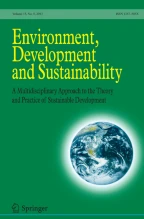Abstract
Recently, industry, suppliers, distributors, academia, governments, and even consumers have focused on agri-food supply chain sustainability, environmental concerns, and managing energy and other resources essential for human survival. A supply chain model is a network of facilities and operations involving processes related to procuring raw materials from suppliers, producing and developing products on production sites, and ultimately distributing products at final consumption destinations. This study aims to propose a multi-stage model for sustainable supply chain network design. After an overview of operations research methods for sustainable supply chain network design, this study proposed a hybrid method based on multi-criteria decision-making (MCDM) and optimization techniques in operations research. The criteria extracted from library resources were selected using the Delphi method in the first step. Then, the criteria for selecting suppliers, transformer sites, and critical distribution hubs were weighted using the best–worst method. After weighing the criteria using the Complex Proportional Assessment of alternatives (COPRAS) technique, eight raw material suppliers, three potential transformer sites, and five main distribution hubs were selected for supply chain network design. The second part presented a multi-objective mixed-integer linear programming model to optimize the designed supply chain network. All three sustainability dimensions, i.e., economic, social, and environmental, were considered in developing the supply chain network. In the economic dimension, we sought to minimize total costs consisting of transportation costs, the cost of construction, maintenance, and closure of transformer and distribution sites, the cost of the capacity change of transformer and distribution sites, and the cost of production. In the social dimension, we sought to maximize the number of job opportunities created in each facility. We sought to minimize carbon and nitrous oxide footprints and water consumption in the environmental dimension. Furthermore, a fourth objective function was presented to minimize product delivery time in addition to the three dimensions of sustainability. Then the proposed mathematical programming model was solved using the LP-metric method, and the necessary comparisons were made between the results. Finally, agri-food industry executives were given a decision-making tool by generating Pareto frontier graphs.
Similar content being viewed by others
Availability of data and materials
The corresponding author's data supporting this study's findings are available upon reasonable request.
References
Allaoui, H., Guo, Y., Choudhary, A., & Bloemhof, J. (2018). Sustainable agro-food supply chain design using two-stage hybrid multi-objective decision-making approach. Computers and Operations Research, 89(2018), 369–384.
Awasthi, A., Govidan, K., Gold, S., (2018). Multi-tier sustainable global supplier selection using a fuzzy AHP-VIKOR based approach. International Journal Production Economy,195, 106e117.
Banaeian, N., Mobli, H., Nielsen, I. E., & Omid, M. (2015). Criteria definition and approaches in green supplier selection—A case study for raw material and packaging of the food industry. Production & Manufacturing Research: An Open Access Journal, 3(1), 149–168.
Carter, C. R., & Easton, P. L. (2011). Sustainable supply chain management: Evolution and future directions. International Journal of Physical Distribution & Logistics Management, 41(1), 46–62.
Chen, C. (2004). Multi-objective optimization of multi-echelon supply chain networks with uncertain product demands and prices. Computers & Chemical Engineering, 28(6–7), 1131–1144.
Cheraghalipour, A., Paydar, M. M., & Hajiaghaei-Keshteli, M. (2018). A bi-objective optimization for citrus closed-loop supply chain using Pareto-based algorithms. Applied Soft Computing, 69(2018), 33–59.
Fathi, M. R., Banaei, A., & Nasrollahi, M. (2019). Designing a closed loop supply chain network considering the uncertainty in the quality of returning products and solving it with the Lp-shape scenario reduction algorithm. Journal of Quality Engineering and Management, 8(4), 292–309.
Hwang, C.L., & Masud, A. (1979). Multiple objective decision-making methods and application: A state of the art survey. In Lecture notes in economics and mathematical systems (vol. 164). Springer.
Osranek, R., (2016), Nachhaltigkeit in Unternehmen: Überprüfung eines hypothetischen Modells zur Initiierung und Stabilisierung nachhaltigen Verhaltens. Springer-Verlag, Wiesbaden.
Puji, N. K., Carvalho, M. S., & Costa, L. (2017). Green supply chain design: A mathematical modeling approach based on a multi-objective optimization model. International Journal of Production Economics, 183, 421–432.
Rahimi, M., & Ghezavati, V. (2018). Sustainable multi-period reverse logistics network design and planning under uncertainty utilizing conditional value at risk (CVaR) for recycling construction and demolition waste. Journal of Cleaner Production, 172, 1567–2158.
Rezaei, J. (2016). Best-worst multi-criteria decision-making method: Some properties and a linear model. Omega, 64, 126–130.
Sazvar, Z., & Rahmani1 M., Govindan K. (2018). A sustainable supply chain for organic, conventional agro-food products: the role of demand substitution, climate change and public health. Journal of Cleaner Production, 194, 564–583.
Seuring, S., & Müller, M. (2008). From a literature review to a conceptual framework for the sustainable supply chain management. Journal of Cleaner Production, 16(15), 1699–1710.
Soleimani, H., Kannan, G. K., Hamid, S. H., & Hamid, J. H. (2017). Fuzzy multi-objective sustainable and green closed-loop supply chain network design. Computers & Industrial Engineering, 109, 191–203.
Xie, G. (2015). Modeling decision processes of a green supply chain with the regulation on energy saving level. Computers & Operations Research, 54, 266–273.
Zavadskas, E. K., Kaklauskas, A., & Sarka, V. (1994). The new method of multi-criteria complex proportional assessment of projects. Technological and Economic Development of Economy, 1(3), 131–139.
Funding
Not applicable.
Author information
Authors and Affiliations
Corresponding author
Ethics declarations
Conflict of interest
The authors declare that they have no conflict of interest.
Ethical approval
Not applicable.
Consent to participate
Not applicable.
Consent for publication
Not applicable.
Additional information
Publisher's Note
Springer Nature remains neutral with regard to jurisdictional claims in published maps and institutional affiliations.
Appendix
Appendix
See Tables
8,
9,
10,
11,
12,
13,
14,
15 and
16.
Rights and permissions
Springer Nature or its licensor (e.g. a society or other partner) holds exclusive rights to this article under a publishing agreement with the author(s) or other rightsholder(s); author self-archiving of the accepted manuscript version of this article is solely governed by the terms of such publishing agreement and applicable law.
About this article
Cite this article
Fathi, M.R., Zamanian, A. & Khosravi, A. Mathematical modeling for sustainable agri-food supply chain. Environ Dev Sustain 26, 6879–6912 (2024). https://doi.org/10.1007/s10668-023-02992-w
Received:
Accepted:
Published:
Issue Date:
DOI: https://doi.org/10.1007/s10668-023-02992-w
